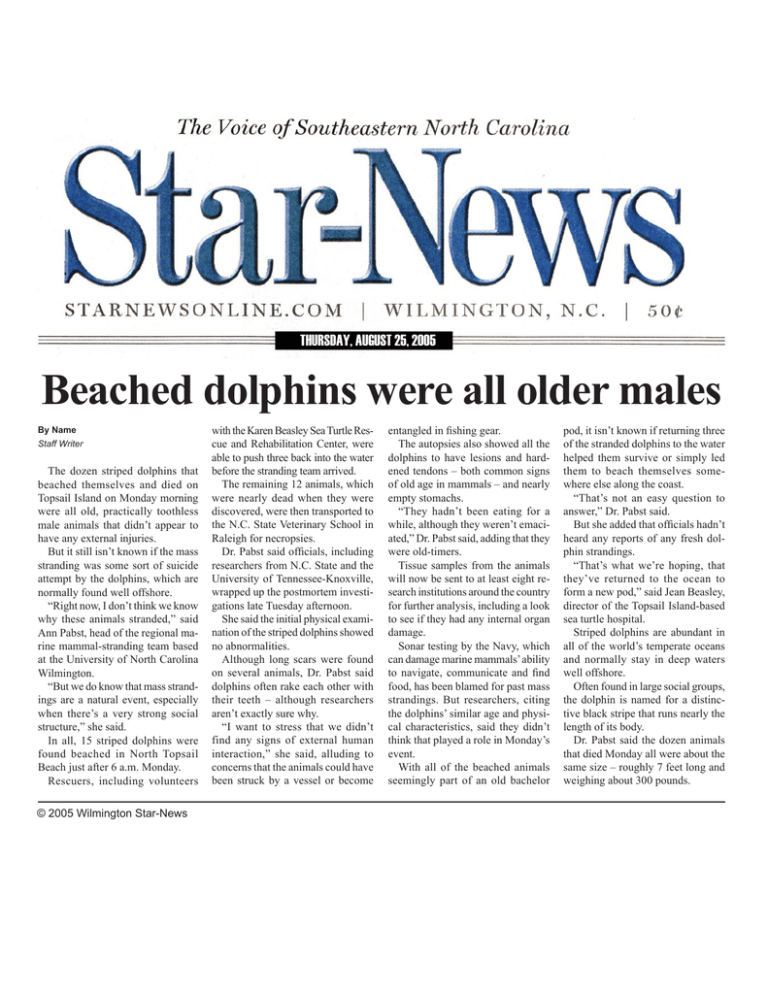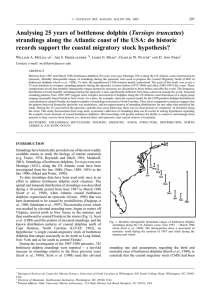with the Karen Beasley Sea Turtle Res-
advertisement

THURSDAY, AUGUST 25, 2005 Beached dolphins were all older males By Name Staff Writer The dozen striped dolphins that beached themselves and died on Topsail Island on Monday morning were all old, practically toothless male animals that didn’t appear to have any external injuries. But it still isn’t known if the mass stranding was some sort of suicide attempt by the dolphins, which are normally found well offshore. “Right now, I don’t think we know why these animals stranded,” said Ann Pabst, head of the regional marine mammal-stranding team based at the University of North Carolina Wilmington. “But we do know that mass strandings are a natural event, especially when there’s a very strong social structure,” she said. In all, 15 striped dolphins were found beached in North Topsail Beach just after 6 a.m. Monday. Rescuers, including volunteers © 2005 Wilmington Star-News with the Karen Beasley Sea Turtle Rescue and Rehabilitation Center, were able to push three back into the water before the stranding team arrived. The remaining 12 animals, which were nearly dead when they were discovered, were then transported to the N.C. State Veterinary School in Raleigh for necropsies. Dr. Pabst said officials, including researchers from N.C. State and the University of Tennessee-Knoxville, wrapped up the postmortem investigations late Tuesday afternoon. She said the initial physical examination of the striped dolphins showed no abnormalities. Although long scars were found on several animals, Dr. Pabst said dolphins often rake each other with their teeth – although researchers aren’t exactly sure why. “I want to stress that we didn’t find any signs of external human interaction,” she said, alluding to concerns that the animals could have been struck by a vessel or become entangled in fishing gear. The autopsies also showed all the dolphins to have lesions and hardened tendons – both common signs of old age in mammals – and nearly empty stomachs. “They hadn’t been eating for a while, although they weren’t emaciated,” Dr. Pabst said, adding that they were old-timers. Tissue samples from the animals will now be sent to at least eight research institutions around the country for further analysis, including a look to see if they had any internal organ damage. Sonar testing by the Navy, which can damage marine mammals’ ability to navigate, communicate and find food, has been blamed for past mass strandings. But researchers, citing the dolphins’ similar age and physical characteristics, said they didn’t think that played a role in Monday’s event. With all of the beached animals seemingly part of an old bachelor pod, it isn’t known if returning three of the stranded dolphins to the water helped them survive or simply led them to beach themselves somewhere else along the coast. “That’s not an easy question to answer,” Dr. Pabst said. But she added that officials hadn’t heard any reports of any fresh dolphin strandings. “That’s what we’re hoping, that they’ve returned to the ocean to form a new pod,” said Jean Beasley, director of the Topsail Island-based sea turtle hospital. Striped dolphins are abundant in all of the world’s temperate oceans and normally stay in deep waters well offshore. Often found in large social groups, the dolphin is named for a distinctive black stripe that runs nearly the length of its body. Dr. Pabst said the dozen animals that died Monday all were about the same size – roughly 7 feet long and weighing about 300 pounds.


